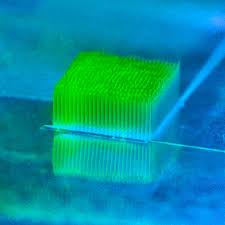Researchers created tiny “skyscrapers” for bacteria communities, allowing them to produce electricity using just sunlight.
Researchers from the University of Cambridge used 3D printing for high-rise grids of ‘nanohousing’, where sun-loving bacteria could grow quickly. The researchers were able to extract the waste electrons from bacteria, which can be used to power small electronic devices.
While other research teams have also extracted energy from photosynthetic bacterium, the Cambridge researchers discovered that they are able to extract more energy if they have the right home. This approach is more competitive than traditional methods for renewable bioenergy generation, and it has already achieved solar conversion efficiency that can surpass many of the current methods of biofuel production.
The results were published in the journal Nature Materials and open up new possibilities for bioenergy generation. They suggest that ‘biohybrids’ could play an important role in the zero-carbon energy mix.
While current renewable technologies like silicon-based solar cell and biofuels are superior to fossil fuels in terms carbon emissions, they have some limitations. For example, they rely on mining and can be difficult to recycle. They also rely on agriculture and land use which leads to biodiversity loss.
“Our approach is an important step towards creating even more sustainable renewable power devices for the future,” Dr. Jenny Zhang, Yusuf Hamied Department of Chemistry who led the research, said.
Zhang and her colleagues at the Department of Biochemistry and Department of Materials Science and Metallurgy work together to rethink the concept of bioenergy and make it more sustainable and scalable.
The most abundant form of life on Earth is photosynthetic bacteria or cyanobacteria. Researchers have attempted to “rewire” the photosynthesis mechanism of cyanobacteria for several years in an effort to extract energy.
Zhang said that there was a bottleneck in the amount of energy you could extract from photosynthetic system, but nobody knew where it was. Most scientists believed that the bottleneck was in bacteria or on the biological side of things, but it turns out that there is a significant bottleneck on the material side.
Cyanobacteria require lots of sunlight to grow. It is similar to the summer surface of a lake. The bacteria must be attached to electrodes in order to harness the photosynthesis energy.
The Cambridge team 3D printed custom electrodes from metal oxide nanoparticles. These electrodes were specifically designed to work with cyanobacteria during photosynthesis. The electrodes were printed in densely packed, highly branching pillar structures that look like a small city.
Zhang’s team created a printing method that can control multiple length scales. This makes the structures highly customizable and could be used in a variety of fields.
Zhang said that the electrodes are light-handling and have great properties. “Cyanobacteria require something that they can attach to, and create a community with their neighbours. Our electrodes provide a balance between a lot of surface area and lots light, much like a glass tower.
Researchers found that the self-assembling cyanobacteria in their new wired home were more efficient than current bioenergy technologies such as biofuels. This technique was able to extract more energy than other methods of producing bioenergy from photosynthetic photosynthesis by an order of magnitude.
Zhang said, “I was surprised that we were able achieve these numbers – similar numbers are predicted for many years but this is the first experimental demonstration of these numbers.” “Cyanobacteria can be used as versatile chemical factories. Our approach allows us access to their energy conversion pathway early, which aids us in understanding how they perform energy conversion. This helps us use their natural pathways to renewable fuel and chemical generation.
